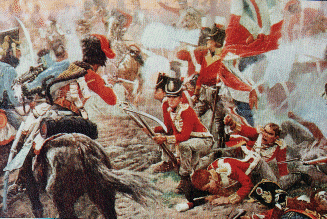
Britain

Introduction
"The British infantry is the finest in the world. Fortunately there are not many of them." - Marshal Thomas Bugeaud.
British infantry earned their reputation on the battlefields of the Peninsular War and at Waterloo. Their motivation and training, combined with the tactics employed by their brilliant commander, the Duke of Wellington, made them almost invincible.
Wellington was probably one of the first commanders to notice that the increasing effectiveness of musket fire meant that the balance in warfare was shifting in favour of the tactical defence. By making skilful use of the ground, and deploying his men in line, Wellington was able to prove his point time and time again - at Vimeiro, Talavera, Busaco, Fuentes de Onoro, Albuera. The contrasting tactics employed by the British and French were graphically described by Marshal Bugeaud thus:
"As soon as we got about 1000 metres from the English line, our men would begin to get restless and excited. They exchanged ideas; the march began to get hurried. Meanwhile the English, silent and impassive, arms at the port, looked like a long red wall - most forbidding to our young soldiers. As we get closer shouts of "Vive l'Empereur! En Avant! A la baionette!" break from our ranks. Our march becomes a trot; men fire their muskets into the air. Three hundred yards in front, the scarlet line stands motionless. They do not seem impressed by the storm which threatens to break over them. It is a striking contrast. Some of us begin to think that it will be devastating when, at last, they do fire. Their unshakeable calm is unnerving. Our enthusiasm begins to wane. We try to restore our confidence by redoubled shouting. At last, the English muskets come down - they are making ready. Appalled, many of our men halt and open a scattered fire. Then comes the English volley, precise, deadly, thunderous. Decimated, our column staggers, half turns, tries to regain its balance. The enemy break their long held silence with a cheer. Then a second volley, perhaps a third and, with the third, they are at us, chasing us in a disorderly retreat."
The final test of the superiority of the "thin red line" came at Waterloo - when the British 1st Foot Guards repelled the massed columns of Napoleon's Imperial Guard.
[an error occurred while processing this directive]